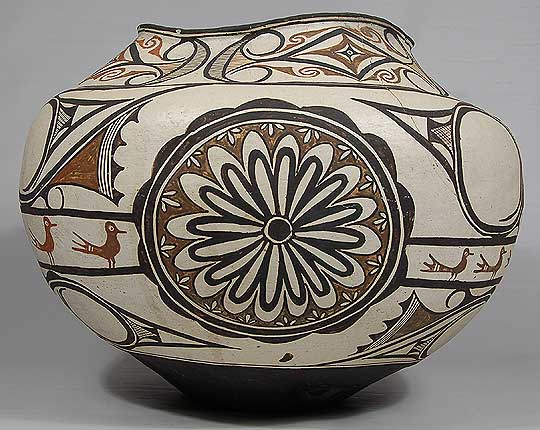Adobe Gallery Blog
Title: Zuni Pueblo Polychrome 19th Century Olla
The interior of the neck of this large magnificent jar is painted black with a narrow band that is left in the matte state, not polished. It has been noticed that jars with narrow black bands inside the rim tend to be earlier than jars with wider bands. This is a distinctive trait of Zuni Polychrome jars starting around 1870.
The bottom area of the jar is painted the traditional black that was transitioned from the previous red underbodies starting as early as 1850 and approaching completion around the late 1890s.
The predominately rounded shape of the jar is typical of Zuni Polychrome jars of the 1870-1880 periods. At the same time, the strong puki flexure that existed in the Kiapkwa periods is noticeably lessened on this jar but is still evident to the touch, something noted starting around 1870.
The design layout on this jar is typical of that which began in the 1870s, which is inclusion of a beautifully executed neck design with the main body design being divided horizontally by a band of birds encircling the mid-body of the jar. The previous use of a vertical rectangular design being used as dividing the mid-body was replaced by a beautifully large rosette or medallion at this time. These rosettes appeared around 1870. They have been attributed to Spanish rosettes carved into furniture or to the sunflower painting on the Zuni Salimopiya Katsina face.
The main body design features large capped spirals above and below the band of small red birds that originated in the pre-1850 periods but continues even to today. They have sometimes been called volute elements.
Based on information above, it is determined that this magnificent jar was made in the period around 1880, possibly as early as the 1870s.
The information presented here is derived from the inclusive 600-page book published in 2008 exclusively on the pottery of Zuni Pueblo by Dwight Lanmon and Francis Harlow. This is a comprehensive study of Zuni pottery and is an invaluable research resource. It is from such research that it is now easier to estimate the date a specific vessel was made.
Condition: When the jar arrived at Adobe Gallery, we noticed two hairline cracks from the rim running vertically down the body of the vessel on opposing sides. We had the cracks professionally stabilized to prevent further damage. There is no other damage or repair to our knowledge.
Title: Zuni Pueblo Polychrome 19th Century Olla
Potter Unknown
Category: Historic
Origin: Zuni Pueblo
Medium: Native Materials
Size: 11" tall x 15-1/8" diameter
Item # C3122


